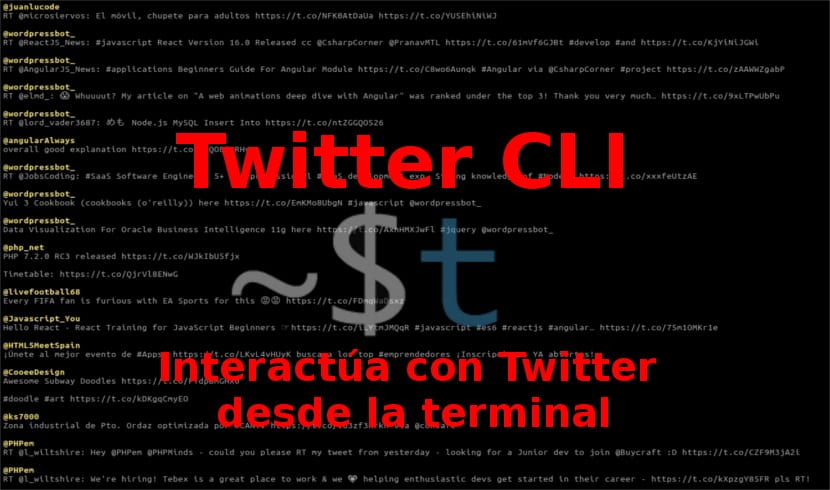
In the next article we are going to take a look at Twitter CLI, or just t. Today, I have started using the CLI mode more than the GUI on my desktop. Working from the command line is a fun, fast, safe and recommended way to learn how to use Gnu / Linux.
Every day, I spend time on Gnu / Linux forums, websites, and blogs looking for CLI alternatives to the GUI applications I use the most. Like I say, I stumbled upon a Twitter client for command line called "Twitter CLI" or simply "t". This will allow us to interact with Twitter from our terminal. It is a great application with which fans of the terminal can enjoy very good times on this social network.
Installation
First of all we will have to make sure we have Ruby installed in our system. On DEB-based systems like Ubuntu or Linux Mint, the following command will install Ruby:
sudo apt install ruby-dev
Now, we can install "Twitter CLI" using command:
sudo gem install t
This command will install the "Twitter CLI" tool along with all the dependencies.
Note: In case you have a PATH related error of the system, we can add ruby to our PATH variable. If the terminal didn't return an error, just skip this part.
In my case, I have added the following to my PATH:
echo 'export PATH="$HOME/.gem/ruby/2.4.0/bin:$PATH"' >> ~/.bashrc
To update the PATH changes, we will execute:
source ~/.bashrc
Next, we should be able to install "t" using the following command:
sudo gem install t
Configuration
Before using t, we will first have to register an application with Twitter. For this we will have to follow the following steps.
First we will have to log in to the Twitter app management site. Then you will have to click on «Create new app«.

We will complete the required fields and submit the form. Keep in mind that the request must have a unique name. Next, we are going to move to the «Permissions » y change the Access settings to "Read, write and access direct messages". A mobile phone number must be associated with your Twitter account to get typing privileges.

Now is the time to move to the tab «Keys and access codes» to see the API Key and APISecret that we will need to copy and paste when the program requests it.
Authorize the client
We have already installed "t" and created and registered an application on Twitter. Now, we need authorize this tool with our Twitter account. To do this, we will execute in the terminal (Ctrl + Alt + T):
t authorize

A dialog box will appear. In it, we will be told to press the ENTER key to open the Twitter Developer site and copy / paste the API Key and APISecret when requested. We will just have to follow the steps.
At the end, if we get the message «authorization successful", Congratulations! We will have correctly configured "t" with our Twitter account.
To see the list of all the accounts that we have authorized, we will execute:
t accounts
This option will show us users who are authorized in our system to use the application. If you authorize more than one account, the last authorized account will be set as active.
For make another account active, just mention the username and your consumer password as below:
t set active sapoclay RQi8DiW4IuPt
All authorized account data will be stored in the file ~ / .trc. You can view the details of the accounts at any time by using the command:

cat ~/.trc
Use Twitter CLI
Arrived here, it is now to see how send a tweet. For this we will only have to execute:

t update "Enviando un Tweet desde la consola de Ubuntu"
As you can see in the following screenshot, the tweet is published on Twitter without problem and immediately:

A highlight of this tool will be that will show us how to delete our last tweet. To delete the previous tweet, I had to execute the following command:
t delete status 913726339378827270
For include special characters in our tweets, we will only have to wrap it with single quotes instead of double quotes, so those characters are not interpreted by our shell. If you use single quotes, your Tweet obviously cannot contain any apostrophes unless you set them with a backslash.
Now we know how to post a tweet and how to delete it. We can also view the full details of a Twitter user if we know the name of the user. We can see the details of your account using the command:
t whois @ubunlog
To see the statistics of a user, we will only have to execute:
t users -l @ubunlog
There are more options, but the article would get too long. To see the full list of available commands, we will only have to execute:

t help
We can consult all its characteristics and other properties of this project on its page of GitHub.